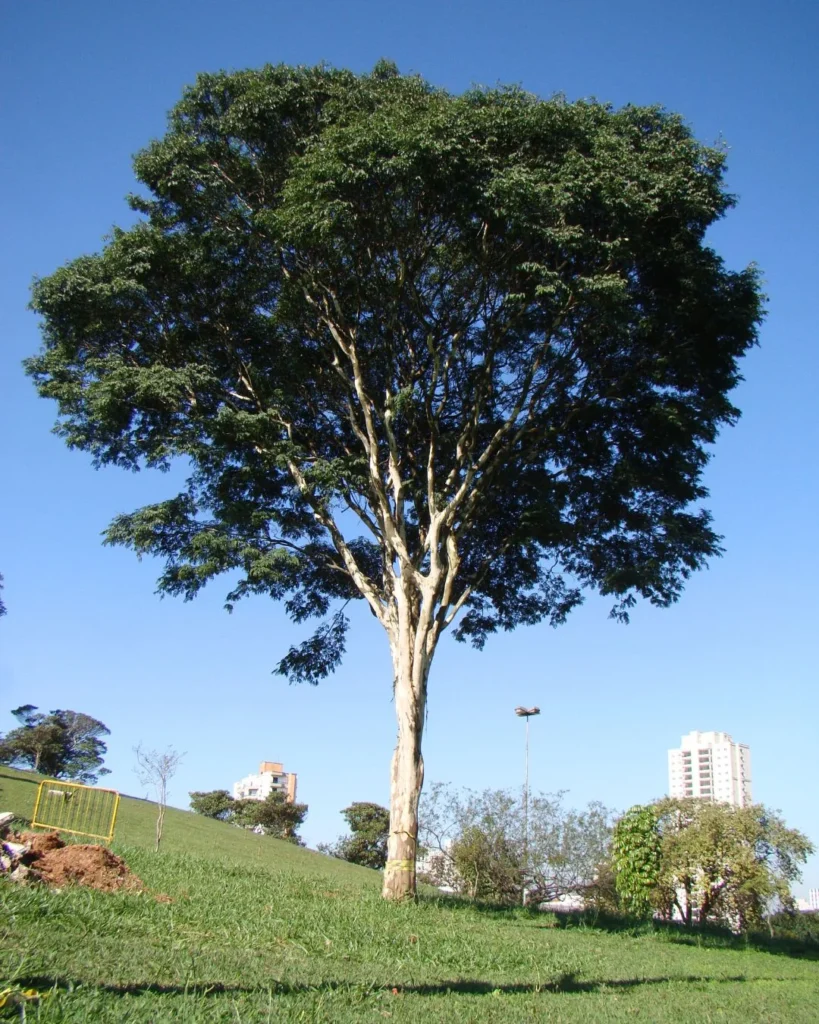The Brazilian Ironwood, recently reclassified from Caesalpinia leiostachya to Libidibia ferrea var leiostachya, is a perennial to semi-deciduous tree of imposing beauty, used in landscaping projects in Brazil and worldwide. It is native to the Atlantic Forest, occurring from the Southeast to the Northeast of Brazil, in the Atlantic slope rainforests (dense ombrophilous forest). Notable for its quality, the wood of the Brazilian Ironwood is considered one of the densest and heaviest found in the American continent.
Its canopy is rounded and wide, with a diameter of about 20 to 39 feet (6 to 12 meters). The tree has a majestic stature, reaching heights of 66 to 98 feet (20 to 30 meters). Its trunk has a diameter of 1.6 to 2.6 feet (50 to 80 cm). It is light-colored, marbled, smooth, and flaking, revealing patches ranging from gray to green, which gives it a very ornamental effect. The leaves are bipinnately compound, with numerous elliptical, opposite leaflets, dark green in color.

The flowering of the Brazilian Ironwood occurs in the summer and autumn, producing panicle-type inflorescences, axillary or terminal. The flowers are small, yellow, graceful, but of secondary ornamental importance. The fruits that follow pollination are hard pods that mature in winter and contain one to four seeds. Some of the fruits fall, while a good portion remains on the plant, forming a sort of aerial seed bank, important for the preservation of the species. The seeds are brown, oblong.
The Brazilian Ironwood is highly sought after in landscaping for its ornamental characteristics and shading. Its marbled trunk provides a separate attraction, making it a favorite among many landscapers. Despite its large size, it does not have aggressive roots, which is an important factor for urban tree planting. However, planting should be avoided on sidewalks, under electrical wires, and in areas with heavy pedestrian and vehicle traffic, as branches that break and fall during storms can become hazardous.

The Brazilian Ironwood is also a suitable choice for areas requiring natural shading, thanks to the density of its foliage. It is an interesting option for large spaces, such as parks, squares, and large gardens, where it can be used alone as a focal point, or in rows and groups. In the restoration of degraded areas, the Brazilian Ironwood is an excellent choice, as it grows well in open areas, and attracts and shelters native birdlife, thus contributing to the regeneration of the delicate Atlantic Forest ecosystem.
As its name suggests, the Brazilian Ironwood has hard, extremely dense, durable, and resistant wood, of excellent quality for making the noble parts of guitars, violins, canes, golf clubs, billiard cues, as well as for civil construction, in the construction of beams, posts, rafters, openings, flooring, etc. Due to its quality, it is known as the “Brazilian ebony.” It is believed that the tree’s name derives from the metallic sound and sparks that occur when axes attempt to cut its trunk. The density of its wood is so high that it is more struck by lightning than other trees. Brazilian natives historically used to make powerful clubs from its wood.

The Brazilian Ironwood should be cultivated in full sun, in fertile, drainable soil, enriched with organic matter, and watered regularly in the first year after transplanting the seedlings. Once well-established, they develop deep roots and are capable of withstanding short periods of drought. Its growth is considered fast, although generally, trees with high-density wood tend to grow more slowly.
Propagation is through seeds, which should be scarified before planting to break dormancy. Seedbeds or tubes should be kept in partial shade and watered in the morning and afternoon. They will emerge 20 to 30 days after planting. The seedlings should be transplanted to larger bags or to the final location when they reach a height of approximately six centimeters (about 2.36 inches).



